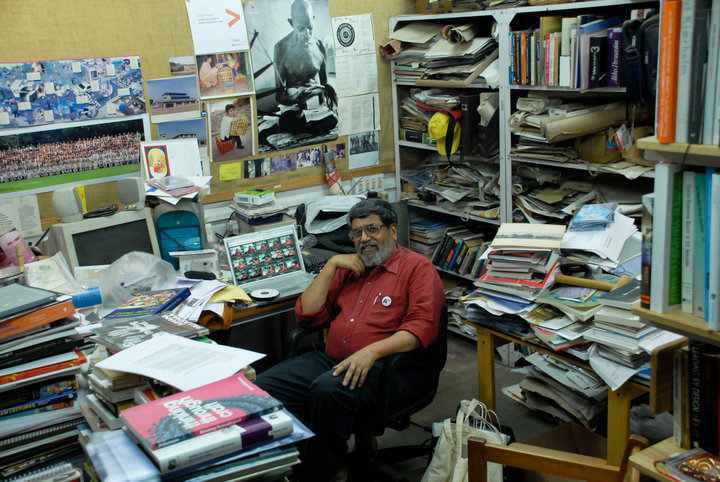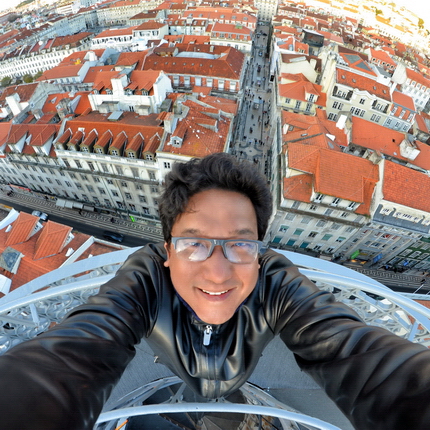 I choose not to write ‘obituaries’. Well, I find most of them well meaning, but, most times unbearably eulogistic, with the expected greatness of a life well lived, heaped and thrust upon the recently departed. He passed away yesterday, and I recall that November afternoon, sixteen years ago when I first conversed with M.P. Ranjan in the quiet confines of a rather atmospheric room at the National Institute of Design (NID), Ahmedabad, India. He was chairing an interview panel and I was the interviewee, and my chair was placed to face the panel chair, expectedly so. After the panel’s round of questions seemingly got over, I looked across the mirror like table top, to the serious but friendly faces, to finally rest on the panel chair, the bearded gentleman who appeared to be watching me very closely. Then he spoke. “So, what are your fears?”. I thought not of my fears till that moment, so an awkward pause from me followed, followed by a rather deflective, if you may, an answer, on the lines of ‘facing them head on’. I am still trying to face my fears.
I choose not to write ‘obituaries’. Well, I find most of them well meaning, but, most times unbearably eulogistic, with the expected greatness of a life well lived, heaped and thrust upon the recently departed. He passed away yesterday, and I recall that November afternoon, sixteen years ago when I first conversed with M.P. Ranjan in the quiet confines of a rather atmospheric room at the National Institute of Design (NID), Ahmedabad, India. He was chairing an interview panel and I was the interviewee, and my chair was placed to face the panel chair, expectedly so. After the panel’s round of questions seemingly got over, I looked across the mirror like table top, to the serious but friendly faces, to finally rest on the panel chair, the bearded gentleman who appeared to be watching me very closely. Then he spoke. “So, what are your fears?”. I thought not of my fears till that moment, so an awkward pause from me followed, followed by a rather deflective, if you may, an answer, on the lines of ‘facing them head on’. I am still trying to face my fears.
So, for seven years or so, we were faculty colleagues, Ranjan and I, at the NID. We crossed paths occasionally, mostly unintentionally. But his presence overrode those unintentional occasions, for rarely have I come across a person, who becomes interchangeable with an institution of national importance and significance, for over decades, he has been so passionately involved with all aspects of life at the NID – a familiar figure in the classrooms, workshops, forums, meetings, library, corridors and the spaces of leisure, voicing his opinions in no uncertain terms. His forthrightness, also won him quite a few detractors, not that he would in any way, change his opinion. He, unknowingly, taught me an important life lesson one day. In a somewhat tense faculty forum (the tension emanating from the then administrations ‘style of functioning’), he, uncharacteristically, got agitated, and voiced (addressing the administration) that he be sacked, if he is not found suitable anymore to be a part of the NID. The ability to put everything on the line, does not come from silly foolhardiness, but from a very firm and deep conviction of the ‘righteousness and justness’ of what one believes in. And, over the years, I found more resonances with Ranjan’s ‘ways of being’, rather than his ‘ways of seeing.’
His extensive work with craft communities over many decades, I believe, shaped him in many ways – Ranjan was a ‘big picture’ person, being constantly aware of the inter-relatedness of entities, that when you touch one thing, it changes something else elsewhere. To achieve some semblance of harmony within that chaotic flux becomes a desirable. He was also, much leaning towards community rights and aspirations, though he probably never addressed it explicitly, his general distrust of ‘top-down directives’ and support for democratic tendencies, his concern for the well-being of a larger populace (green design and improved public transportation and furniture being cases in point), along with his life-long dedication to knowledge and know-how transfer, constantly hinted at someone who was very aware of his own connectedness with communities of fellow humans. He also believed that design is etched in our ways of life, a cursory look at even our rudimentary customs and rituals will affirm that fact.
Another aspect of Ranjan’s ‘ways of being’ was that he comfortably inhabited somewhat varying areas of competence, as voiced to me once “I don’t dabble” – he was a toy designer, a furniture designer, a product designer, who also straddled digital design and interactive hypermedia spaces with equal ease, along with authoring national level policy documents and networking for pedagogic revisions and improvements. He did not inhabit one space, and that is significant, and certainly brings to mind what noted cultural critic Edward Said responded with, when asked of him: “Who are you?”. His response: “I think I identify myself as a kind of an intellectual person who travels a lot, between things. I don’t think of myself as inhabiting a field or place really. Obviously, I have an ‘address’, but you know it is not an ‘address’ that means that much to me. I like to think of myself as an energy in motion …. I have spent a lot of time invading other fields.” (Interview by Michaël Zeeman for the Dutch television programme ‘Leven en Werken’, VPRO, 1999).
Ranjan popped into my cabin one day, and started discussing the legitimate history of Indian design. I was entirely unprepared for it, and probably half-hinted at the same; but then, that was him. He can disarm you with a line, even a smile, exuding affability.
Being Ranjan could not have been easy. But then, he would not have it any other way.
Adios Ranjan, we shall meet again.
10th of August, 2015.
Addendum: 09 August 2017. A note, two years after the first publication of this piece. When I look back at my years with Ranjan, I sensed then, as I sense now, as to how ‘driven’ he was, this zeal and drive propelled by significant convictions and energies. I would like to believe, though cautiously so, that part of it had to do with his point of entry into the NID, as a student of design in 1969. In sharing anecdotes about his tryst with design, he would sometimes mention that most of his colleagues in the programme were accomplished architects and so on, while he entered the programme as an ‘experienced cabinet maker’. I am not sure the tag of a ‘cabinet maker’ sat easy on him, and variously, one can imagine Ranjan driving himself to better his ‘more accomplished’ colleagues. A persistence with chasing excellence (rather than mediocrity) that coloured much of his life and work.
(For the uninitiated, you can find out more about Ranjan here)
(Ranjan in class, 5th of October, 2012)
(Photograph: Ranjan in his office at the NID / Photo by: Sumit Kathuriaa)

 We need more teachers like you :)
We need more teachers like you :) Photo gallery
Photo gallery Never thought I’d say this, but it was the most interesting classes I’ve sat in.. and of course, the day you played Sultans of Swing for us. Hope you continue to influence the next generations with your dynamic yet simple teachings.
Never thought I’d say this, but it was the most interesting classes I’ve sat in.. and of course, the day you played Sultans of Swing for us. Hope you continue to influence the next generations with your dynamic yet simple teachings. OMG its like a painting!! you have taken photography to another level!!!
OMG its like a painting!! you have taken photography to another level!!! You are inimitable!
You are inimitable! You’re a role model sir, such awesomeness !!! :D
You’re a role model sir, such awesomeness !!! :D Photo gallery
Photo gallery Photo gallery
Photo gallery Photo gallery
Photo gallery I discover TL of a writer and respected intellectual, with a tolerant, global conscience: @GhoshAmitav – tx @Milindo_Taid
I discover TL of a writer and respected intellectual, with a tolerant, global conscience: @GhoshAmitav – tx @Milindo_Taid Photo Gallery
Photo Gallery Photo gallery
Photo gallery Your website is full of delightful posts. I’m going to have to watch where my time goes when I’m visiting! :)
Your website is full of delightful posts. I’m going to have to watch where my time goes when I’m visiting! :) veryveryinterestingwebsite.have been visiting! thankyou!
veryveryinterestingwebsite.have been visiting! thankyou! Oldest operating bookstore
Oldest operating bookstore This is great…..in fact the entire website is a wonderful treasure. thanks sir!
This is great…..in fact the entire website is a wonderful treasure. thanks sir! Just detected your blog: impressive. wishing you continued inspiration and health.
Just detected your blog: impressive. wishing you continued inspiration and health. I was just looking at your website… amazing it is… full of knowledge as always..
I was just looking at your website… amazing it is… full of knowledge as always.. You are the only faculty member I could connect to!
You are the only faculty member I could connect to! With all the magical places you are checking off your bucket list! I want to know how to be you :)
With all the magical places you are checking off your bucket list! I want to know how to be you :) Photo gallery
Photo gallery Photo gallery
Photo gallery Photo gallery
Photo gallery Absolutely amazing blog – a chest full of treasure.
Absolutely amazing blog – a chest full of treasure. love ur pics…they are like those moments which u capture in your mind and wished u had a camera right at that moment to capture it…but u actually do capture them :) beautiful…!!!
love ur pics…they are like those moments which u capture in your mind and wished u had a camera right at that moment to capture it…but u actually do capture them :) beautiful…!!! Hi Milindo, hope you are inspiring many more around you…wherever you are!
Hi Milindo, hope you are inspiring many more around you…wherever you are! Guitar in your hand reminds me of the MCRC days! You are terrific… :)
Guitar in your hand reminds me of the MCRC days! You are terrific… :) Photo gallery
Photo gallery Photo gallery
Photo gallery Photo gallery
Photo gallery So glad you enjoyed my photos, really honored to be featured on your blog. thank you sir!
So glad you enjoyed my photos, really honored to be featured on your blog. thank you sir! Photo Gallery
Photo Gallery Photo gallery
Photo gallery hope you’re changing the world as always :)
hope you’re changing the world as always :) Milindo Taid – ace teacher, rockstar guide to my projects at film school, guitarist and photographer too. Really good human being as well
Milindo Taid – ace teacher, rockstar guide to my projects at film school, guitarist and photographer too. Really good human being as well Its really good to see you Milindo, with such awesome stuff from you as usual.. loved your blog as well!
Its really good to see you Milindo, with such awesome stuff from you as usual.. loved your blog as well! Photo gallery
Photo gallery You’ll love this site by the awesome Milindo Taid
You’ll love this site by the awesome Milindo Taid #NowFollowing @Milindo_Taid One of the most influential n interesting mentor from my design school. Always loaded. :)
#NowFollowing @Milindo_Taid One of the most influential n interesting mentor from my design school. Always loaded. :) This is by far amongst the best curated creative content sites out there and the eye and vision of one man, when good, works better than any funded team. Inspired enormously once again :)
This is by far amongst the best curated creative content sites out there and the eye and vision of one man, when good, works better than any funded team. Inspired enormously once again :) Photo gallery
Photo gallery Milind never told u but u were my first true inspiration….I almost learnt the guitar watching u play…..thanx for being there
Milind never told u but u were my first true inspiration….I almost learnt the guitar watching u play…..thanx for being there Photo gallery
Photo gallery i really like your blog – good interesting stuff as always !
i really like your blog – good interesting stuff as always ! Love your site Milindo. I was excited to see you displaying my husband’s watermelon carvings
Love your site Milindo. I was excited to see you displaying my husband’s watermelon carvings great blog :)
great blog :) Photo Gallery
Photo Gallery Photo gallery
Photo gallery Photo gallery
Photo gallery You are awesome :)
You are awesome :) Your courses were always the best. By the way, just went through a bit of your website. It’s great! Some good stuff in there that I wouldn’t normally chance upon
Your courses were always the best. By the way, just went through a bit of your website. It’s great! Some good stuff in there that I wouldn’t normally chance upon Photo gallery
Photo gallery Grt milindo. eachtime want to check out something good on net…know where to go now!
Grt milindo. eachtime want to check out something good on net…know where to go now!